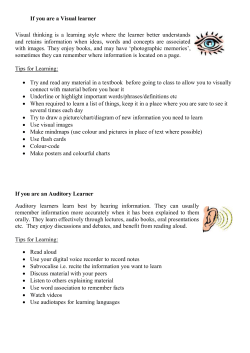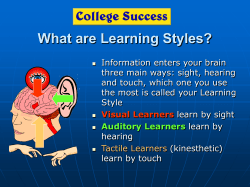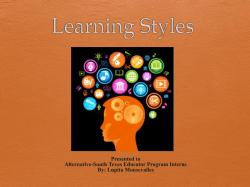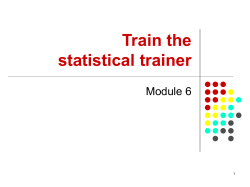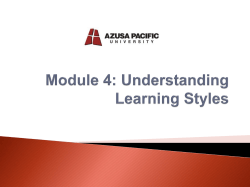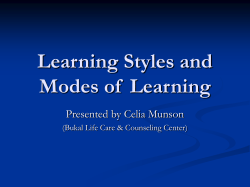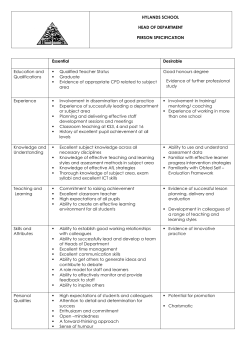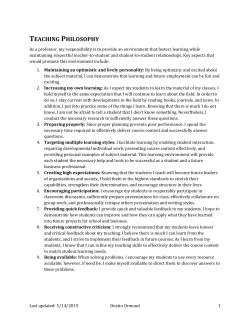
Spotlight on Learning Styles - ELTA (English Language Teachers
Borrowed from Delta Publishing Spotlight on Learning Styles by Marjorie Rosenberg, University of Graz, Graz, Austria Key words: learning styles, myths, misconceptions, VAK learners How my journey began It is always interesting to discuss the concept of learning styles with educators. Although research has been carried out over the last fifty years or so, it is still considered by some to be controversial. Those who feel that learning styles do not exist or have a place in the classroom can point to a wide variety of websites and scholarly articles, while proponents of learning styles can also find a large number of journal articles and research results attesting to the validity of the theories. My interest in this field began in the early 1990s in a course on ‘superlearning’ techniques where I heard about visual, auditory and kinaesthetic learners for the first time. It was as if a door had opened for me and I finally understood why my years of trying to learn French through the audiolingual method had been so resoundingly unsuccessful. As a visual and kinaesthetic learner, being told ‘not to picture the words in my head’ was the wrong way for me to first be confronted with a language. Just listening to the sounds and finding automatic responses or sitting in a language lab with nothing to look at did not help me at all. Years later, when I learned German, I wrote words down myself, carried a dictionary around to look words up and made use of a number of visual aids. This method was certainly more rewarding for me and suddenly finding out what the difference was in the two experiences began my journey into this fascinating area. As a language teacher I became very interested in finding out how I could help my learners to have positive experiences both inside and outside the classroom and discovering and development different possibilities of doing this became a mission. Definitions As one of the first questions which comes up refers to the definition of styles, it seems best to quote some of the experts in the field. For example, Guild and Garger (Guild and Garger 1998: 23) say ‘The way we perceive the world governs how we think, make judgments and form values about experiences and people. This unique aspect of our humanness is what we call “style”’, while J.W. Keefe (Keefe 1979:4) contends that styles are ‘characteristic cognitive, affective and psychological behaviours that serve as relatively stable indicators of how learners perceive, interact with and respond to the learning environment’. Kinsella (Kinsella 1995: 171) comments that learning style refers to ‘ an individual’s natural, habitual and preferred ways of absorbing, processing and retaining new information and skills which persists regardless of teaching methods of content area’ and Dunn and Dunn (Dunn and Dunn 1992, 1993) and Dunn, Dunn, and Perrin (Dunn, Dunn, and Perrin 1994: 11) say that ‘learning style is the way each person begins to concentrate on, process, internalize and retain new and difficult academic information.’ They go on to suggest that ‘More than threefifths of learning style is biological; less than onefifth is developmental.’ Importance in learning Moving on to the importance or use in learning is a subject which inspires debate from all corners of the globe and from people involved in a variety of educational situations. An argument is often made that it is not possible to change instruction to suit every learner and even in cases where this is done, it has no particular effect on the success of the learning outcome. While this may be true, it is only one part of the equation. However, ‘it is possible to strive for uniform outcomes but to intentionally diversify the means for achieving them’ (Guild and Garger 1998:19). Harmer (Harmer 2007: 85) addresses this issue as well when he says that ‘The moment we realise that a class is composed of individuals (rather than being some kind of unified whole) we have to start thinking about how to respond to those students individually so that while we may frequently teach the group as a whole, we will also, in different ways, pay attention to the different identities we are faced with.’ This is not to say that we need to constantly change our instruction to make sure that we reach each and every learner all of the time. But a mix of methods can provide learners with new possibilities and resources for them to explore outside the classroom, including those which are new and different for them. In addition, encouraging learners to try out new methods for themselves can encourage them to become more independent and autonomous learners another goal of helping them to discover their styles. Cohen (ed. Schmitt 2010: 162) sums this up by saying, ‘Indeed we learn in different ways and what suits one learner may be inadequate for another. While learning styles seem to be relatively stable, teachers can modify the learning tasks they use in their classes in a way that may bring the best out of particular leaners with particular learning style preferences. It is also possible that learners over time can be encouraged to engage in ‘stylestretching’ so as to incorporate approaches to learning they were resisting in the past’. Myths and misconceptions As there are a number of misconceptions about learning styles, this is an important area to cover in any discussion of the topic. For one thing, learning styles are not an excuse. Finding out about one’s strengths and weaknesses does not mean that one is allowed to simply give up because he or she is not particularly good at something. The goal instead is to create a mindset in which the person is made cognizant of their particular situation and to expand on it and grow. In any discussion with learners about their styles, the option of falling back on a weakness as a reason not to do something is simply not on the table. It would also be a misconception to assume that learners cannot stretch out of their styles. Although the style can be seen as a foundation, most learners have incorporated methods ascribed to other styles to learn and acquire knowledge. Being aware of the wide range of possibilities in learning does not mean that a learner will not make use of them, if necessary, to achieve a particular goal or when learning a particular subject. And if the learner is successful with this, motivation may improve resulting in a positive selffulfilling prophesy. Another misconception is that teachers tend to label or pigeonhole learners once they know their styles. This is most certainly not the aim of those of us working in this field. It is interesting to observe students and to be aware of their styles as it makes giving advice to particular questions easier, but it does not mean that a teacher should assume a learner cannot grow or change. Teachers can reassure learners that ANY strength or strategy which will help them achieve a goal is fine; there is no need to only use ones most commonly employed by the style. However, learners also need to have the selfconfidence to use the strategies comfortable for them, even if they have been told in the past that these strategies will not help them to learn. In addition, styles are not ‘right’ or ‘wrong’ they are valueless. No style is ‘better’ than another style; one may be more suited to learning a particular skill than another, but each of the styles has their strong and weak points. Style and competence should not be confused. In a language class it is certainly possible that two people with very similar learning style profiles are at completely different levels of language. So many other factors must be considered that simply basing all conclusions about learners on style would be a mistake. It could also be that a learner is enrolled in a programme which is not the right one for him or her. Discoveries about style could lead to making a change, but it may also simply lead to finding new ways to learn the material. Implementation There are a variety of ways in which learning styles can be implemented into the foreign language classroom. In Spotlight on Learning Styles teachers are provided with checklists which they can go through with their students and discuss. Particular characteristics of styles are given as well as tips and strategies. The styles of both the teacher and the students are looked at and suggestions are made as to how to expand a teacher’s repertoire in the classroom. As many of us teach in the way we prefer to learn, we may overlook learners’ needs whose styles are very different from our own. Spotlight on Learning Styles has been written to remind teachers about the types of students in our classrooms and provide tips, hints and ideas to ensure that teachers can reach as many of their students as possible and find both satisfaction and joy in doing so. Style types As there are a large number of learning styles and surveys to determine them used by researchers and practitioners, it was necessary to decide which ones to focus on in Spotlight on Learning Styles . For this reason, the choice was made to choose three particular areas. This logical sequence of gathering information led to the choice of three distinct areas to cover, beginning with visual, auditory and kinaesthetic modalities (sensory channels of perception), global / analytic thought processes (cognitive processing) and Mind Organisation (behaviour based on perception and organization of information). By adding on to the knowledge provided by one style, a more composite picture of a learner can be made. After doing all three surveys the individuality of each of the learners becomes more apparent, the uniqueness of each learner can be appreciated, and suggestions for strategies can be tailored to the particular learner and situation. As Cohen says, ‘Although numerous distinctions are emerging from the literature, three categories of style preferences are considered particularly relevant and useful to understanding the process of language learning: sensory/perceptual, cognitive and personalityrelated preferences’ (Schmitt ed. 2010:163). VAK Learners The standard model of VAK generally includes visual, auditory and kinaesthetic learners. These were researched early on by Barbe and Swassing (Barbe and Swassing 1979:1) who defined what they called modalities as ‘any of the sensory channels through which an individual receives and retains information’. However, after working in adult education and teacher training for some thirty years, it seems that adults tend to be either kinaesthetic motoric (tactile) learners or kinaesthetic emotional ones. The exact age as to when this split takes place has not been determined, but it seems to show up in the later years of high school and is certainly apparent by the time learners reach tertiary level education or take on a job. For this reason Spotlight on Styles looks at these two areas separately and provides ideas for working with both types. Visual learners generally remember best when they can see something or write it down. Examples of activities for them include noticing things about them, using colours, drawing or creating pictures in their minds, recognizing shapes, and describing items or people in writing. Auditory learners remember what they hear or say. Therefore, the activities for them include passing on sentences to each other orally, telling stories or putting them in the correct order through listening, describing people aloud, asking questions, and matching beginnings and endings of the jokes they hear. Kinaesthetic emotional learners need to feel comfortable with others and want to have the feeling of belonging. Therefore, they are given the chance to work together in groups to plan joint events, tell each other’s horoscopes or fortunes, come up with positive adjectives to describe classmates, or tell others how they feel about a particular topic within a safe setting. The kinaesthetic motoric leaners need to move about and learn best when they can try things out for themselves. They are given the opportunity to walk around and mingle to gather information, create the moving parts of a machine in a group, pass on a word by writing on someone’s back, or act words for others to guess. The last section has mixed activities which are designed to appeal to all learner types such as describing, drawing or ‘becoming’ pictures, playing memory in groups, remembering and repeating unusual definitions, as well as kinaesthetic bingo and gap texts. Students are also encouraged to contribute to the activities and if some are more successful than others, they can be asked to help fellow students or give personalised tips on how to remember things better. Global / Analytic Learners Moving onto cognitive processing, we take a look at the global / analytic learning style. One of the first researchers to look into these styles was Witkin (Witkin 1981) who worked with fighter pilots to discover what influenced their decisions while piloting planes. He came up with his theory of fielddependent (global) learners and fieldindependent (analytic) learners based on this research and went on to develop the ‘Group Embedded Figures Test’, still used today to determine cognitive learner styles. Global learners tend to process information holistically and by remembering the entire experience rather than just details. They are also relationshiporiented and may be more emotional than analytic learners. The activities designed to appeal to them include a group drawing exercise to create a person, writing stories about others in the class, coming up with an idea for a class excursion and playing games like ‘YouRobot’. Analytic learners, on the other hand, like details and structure. They may prefer to work alone as they prefer not to be distracted. They are generally selfmotivated and may be quite goaloriented. The activities created for them include finding mistakes, solving logical puzzles, figuring out a detective story, and creating rules for specific activities. Mind Organisation The last of the styles looks at behaviour and is created by putting together the idea of perception as concrete (using the senses) or abstract (using ideas and feelings) and the element of organisation (either systematically or nonsystematically). This gives us four distinct styles which created by Bowie (Bowie 1997) who began her research working with adolescents. She devised a learning style survey called ‘Mind Organisation’ and used it as a basis for counselling high school students and helping them to learn. Her four styles include: ● Flexible Friends, who perceive abstractly through ideas or feelings and organise nonsystematically. ● Expert Investigators, who perceive abstractly through ideas or feelings and organise systematically. ● Power planners, who perceive concretely using their senses and organise systematically ● Radical Reformers, who perceive concretely through their senses but organise nonsystematically Flexible Friends like to work in groups, especially those in which they like the other people. They are creative and intuitive and value personalised learning experiences. They are also enthusiastic and express their empathy for others. Language activities which appeal to them include setting personal goals, writing down sentences which are true for them in a dictation exercise, learning to use vocabulary of emotions and feelings, completing sentences about their partner, and finding things in common with others. Expert Investigators are logical and systematic learners. They tend to be perfectionists so prefer to work at their own speed. In dealing with others they are generally logical and rational. They especially like to do research and to know where they can get information from. The language activities designed for them include working with facts and informative materials, finding errors and doing research for a class excursion followed by a report on how it went. Power Planners like to be organised and are generally detail and taskoriented. In groups they may take on a natural role of a leader and enjoy handson activities. The language tasks designed for them include putting processes in order and explaining them to others, finding explanations and rules for difficult grammar points, using linking words correctly to create plans and setting priorities. Radical Reformers are risktakers and are often curious about a number of different fields of study. They generally rely on their intuition to solve problems, but pride themselves on finding unique ones. They tend to ‘think outside the box’ and value creativity and ingenuity. In groups, they may inspire others and value reallife experiences. The activities for them include realistic role plays, creating and acting out a scenario based on a true story, buying and selling everyday items to each other by finding unusual uses for them, creating statements about themselves which the others guess are true or false. Moving on The information presented here is the start; the end of the journey is up to the readers and users of the book. As learning styles and the discoveries which occur when people become aware of them is a neverending story, the goal of this article and the book itself is to open up a perspective on learning which perhaps had not been considered before. Moving on to personal research or professional development, stretching outside your own comfort zone, or helping students to realise their true potential are only some of the places these ideas can take you. The excitement of discovery remains to those who use the information to delve into themselves and their teaching as well as their students and their learning in whichever way they choose. The impetus is here, the joy of further discovery is up to you. References Bowie, A. 1998. Adolescent Self Perceptions of Learning Styles: A Qualitative Study , Master’s Thesis, Antioch University. Seattle, WA Dunn, R. and K. Dunn. 1999. The Complete Guide to the Learning Styles Inservice System. Boston, MA: Allyn and Bacon. Guild, P. B. and S. Garger. 1998 Marching to Different Drummers. Alexandria, VA: Association for Supervision and Curriculum Development (ASCD). Keefe, J. W. 1979. ‘Learning styles: an overview’ in Keefe, J S (Ed): Student learning styles: diagnosing and prescribing problems. Reston, VA: National Association of Secondary School Principals. Schmitt, N (Ed). 2010. An Introduction to Applied Linguistics Second Edition . New York, NY: Routledge. ***** Marjorie Rosenberg teaches English at the Language Institute of the University of Graz, works with corporate clients and trains teachers. Her publications include In Business and two Personal Study Books in the Business Advantage series (CUP), English for Banking and Finance 2 (Pearson) and Spotlight on Learning Styles (Delta). She wrote activities for the Cambridge University Press website Professional English Online for a number of years and is now working on a book to help teachers write activities for different learner preferences. Marjorie was the IATEFL BESIG coordinator from 20092015 and also served on the IATEFL Membership Committee. She is now Acting Vice President of IATEFL and will be taking over as President at the Annual Conference in Manchester Marjorie.Rosenberg@tele2.at . in April 2015. You may contact her at ***** Article borrowed from Delta Publishing website. First published on Delta Publishing website in 2013. Borrowed from Delta Publishing, courtesy of Delta Publishing. For ELTA Newsletter prepared by Maja Jerković. http://www.deltapublishing.co.uk/titles/methodology/spotlightonlearningstyles
© Copyright 2025
